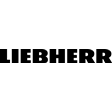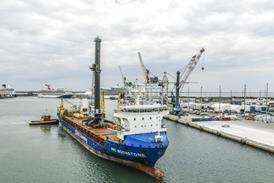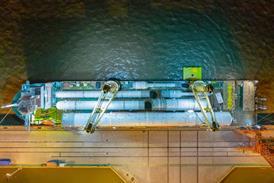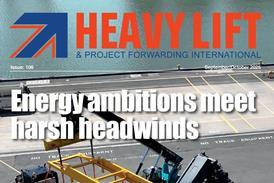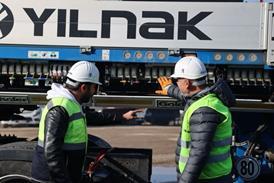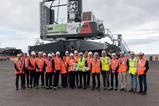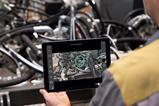As environmental considerations become increasingly important, and the shift away from fossil fuels offers cost advantages, the demand for electric drive types continues to rise. Liebherr offers three different drive types, providing suitable solutions for your specific needs on site.
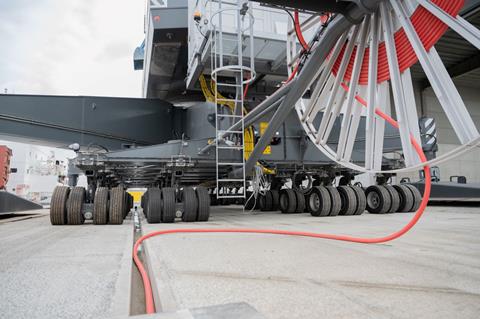
Society is confronted with the topic of greenhouse gas reduction on a daily basis. Consequently, legal regulations and social demands place specific requirements on the manufacturing industry to conserve resources and minimise CO₂ emissions. It goes without saying that the transition to environmentally friendly drive types is essential.
Liebherr is a pioneer in forward-looking product and service development, focusing not only on meeting today’s requirements but also on anticipating the needs of tomorrow. The globally operating company is the market leader in mobile harbour cranes. With an overall production of 2,000 so far and around 1,600 actively used LHMs in more than 100 countries, the demand for fuel is just as considerable as the potential savings from alternative energy sources.
The e-drive allows to operate a crane locally emission-free. Whether installed in a new machine from the beginning or as a retrofit kit, the conversion from diesel to electric drive offers significant benefits, such as cost savings, resource conservation and energy recuperation, to name just a few.
During heavy lift operations, there are frequently waiting periods for the crane. Considering these times when no power is required on the hook, the e-drive is the more environmentally friendly option as the diesel engine emits approximately 24 kg of CO₂ per hour even when the crane is idling.
Additionally, if the grid is fed with renewable energy sources, up to 100 kg of CO₂ emissions per hour can be saved during handling at the quayside with an LHM.
Another interesting fact, besides the advantage of saving costs and resources with regard to needed power, is the state subsidies. Various countries appreciate and therefore support the use of alternative energies in their industries, not least to achieve their own CO₂ targets. Additionally, maintaining an e-drive is less complex than maintaining diesel engines. Hence, no operating fluids need to be checked and replaced in the electric drive and oil filters do not need to be changed either.
Flexible drive systems for mobile harbour cranes
Liebherr offers different types of drive systems according to local circumstances.
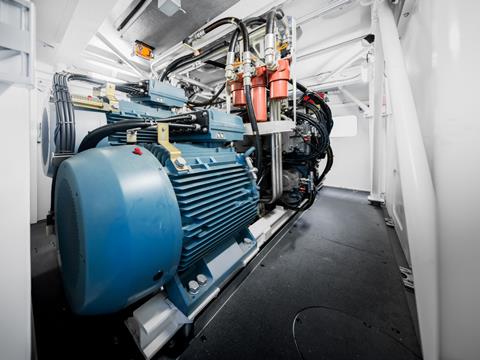
The all-electric drive is available for Liebherr’s portal crane, LPS 420 E, and is connected to the local power grid, allowing locally zero-emission operation. This is made possible by the fact that all crane movements are driven by electric motors. Additionally, the drive concept offers two ways of energy recuperation. The electricity recovered from lowering can be fed back into the local power grid or stored in high-performance capacitors to retrieve the energy when needed.
The electric-hydrostatic drive has technical similarities to the all-electric drive. However, power is transmitted to all crane movements via a hydrostatic drive system. Even with this variant, the drive type is connected to the local power grid, allowing for locally zero-emission operation. The drive concept offers two ways of energy recuperation from the lowering process. Power can either be fed into the local power grid or stored in the hydraulic Pactronic system to be retrieved when needed. This is where the drive type distinguishes itself from the all-electric drive.
The Pactronic system consists of a powerful hydro-pneumatic storage, which temporarily doubles the primary power for highly efficient crane operation. The drives of the main gears, like turning, luffing, lifting etc., use a closed hydraulic system to ensure maximum drive efficiency.
The third option is suitable whenever the mobile harbour crane is used on a quay without electrical infrastructure. In this case, the crane can be operated conventionally with a diesel engine that meets the latest emission regulations. Additionally, the diesel engine can be operated with HVO100 to significantly reduce the CO₂ footprint.
High voltage versus low voltage
For emission-free operation, the Liebherr mobile harbour crane can be connected to a low-voltage network from 400 volts or a high-voltage network up to 20,000 volts. In the case of a high-voltage supply, this is converted into low voltage via a transformer mounted on the undercarriage, so that only low voltage is present in the crane itself. The additionally offered option of a cable-reeling drum ensures the safe movement of the crane with the cable. Different cable lengths can be accommodated in this context, depending on the customers’ requirements and the voltage present at the feed point. This allows emission-free electrical travel of the crane along the quayside, as well as e-powered lifting.
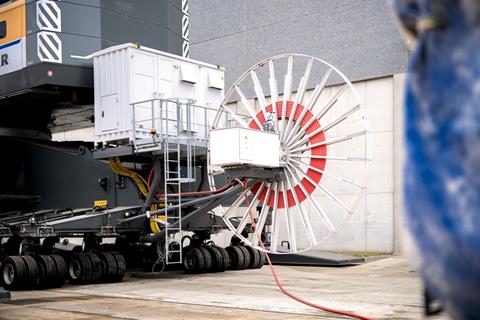
Furthermore, various options are available for the cable position. This includes the cable drum placement on the back of the undercarriage, on the side, or combined with a separate cable car. Even the placement of the cable on the ground can be loosely to benefit from maximum flexibility or embedded in in a duct for maximum protection. Beyond the aforementioned options, Liebherr offers individual solutions to fulfill specific customer demands.
Liebherr’s electric drive for mobile harbour cranes helps you reduce your fuel consumption in your daily work. Whether from initial assembly or as a retrofit kit for later installation, you will make your business more sustainable while also reducing operating costs. With flexible drive systems, regardless of the electrical supply in the local harbour, Liebherr’s e-drive meets versatile demands.
